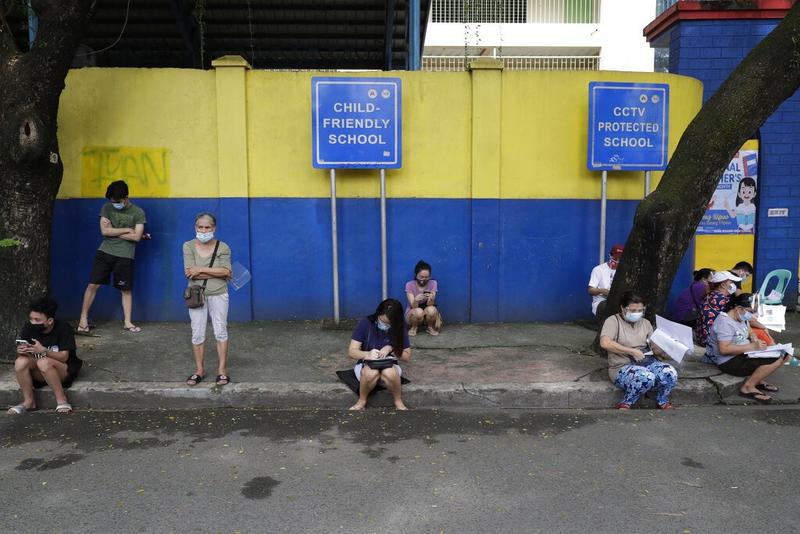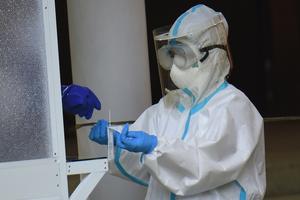 People wearing masks and face shields practice social distancing while waiting for their turn to pick up student electronic tablets ahead of online classes which are scheduled to start next week, in the Dona Rosario High School in Quezon city, Philippines, Oct 1, 2020. (AARON FAVILA / AP)
People wearing masks and face shields practice social distancing while waiting for their turn to pick up student electronic tablets ahead of online classes which are scheduled to start next week, in the Dona Rosario High School in Quezon city, Philippines, Oct 1, 2020. (AARON FAVILA / AP)
Filipino physician Robert Blasco spent long hours treating critical and super-spreader COVID-19 patients at a private hospital in Manila. Aware of the virulent nature of the disease, he bought his own supply of disinfectant, masks and gloves, apart from using the items the hospital
provided.
That did not stop him from contracting the novel coronavirus and he became confined at home for a month, battling cough, fever and severe muscle pain. He has since recovered and will be back on duty soon.
“I will have to go back to work,” Blasco told China Daily. “I can’t turn my back on those dying on the floors or suffering in the emergency room.”
The Philippines has the highest number of COVID-19 cases in Southeast Asia with over 320,000 cases as of Oct 5, according to WHO data
Blasco is just one of the many Filipino health workers who contracted COVID-19. The country’s low public health investment has resulted in an acute shortage of medical professionals, supplies and infrastructure needed to fight the virus.
The Philippines has the highest number of COVID-19 cases in Southeast Asia. There were over 320,000 cases in the Philippines as of Oct 5, according to World Health Organization data. International medical journal The Lancet in a Sept 14 report said the Philippines ranked 66th out of 91 countries in terms of suppressing the spread of the virus.
And this is despite the fact that the Philippines has been subject to lockdown measures since March. President Rodrigo Duterte has even extended the lockdown in Metro Manila until the end of October.
“The ideal approach to controlling highly infectious diseases is to do the basics when you only have few cases,” said Anthony Leachon, chairman of Kilusang Kontra COVID (Movement Against COVID-19). The private-sector-led coalition helps local government officials with their COVID-19 plans and strategies.
He noted that mass testing, contact tracing and quarantining did not go well during the early stages of the pandemic. This is why health officials are now having a hard time containing the spread of the virus as the number of cases is already too high.
Moreover, “we didn’t invest in our public health system. That’s why, during the first few months of the pandemic, we only had one testing center for COVID-19 – the RITM (Research Institute of Tropical Medicine). It took weeks before the RITM could issue test results,” Leachon said.
The World Health Organization said in April that health workers accounted for 13 percent of the total COVID-19 cases in the Philippines. The Department of Health said that more than 5,000 health workers had contracted the novel coronavirus as of August.
Health workers contracted the virus because they were not able to get personal protective equipment fast enough. With health workers themselves falling ill, the country’s healthcare system was easily overwhelmed.
 A medical worker prepares to take swab samples from residents during a mass testing for COVID-19 at a park in Quezon City, suburban Manila, on April 15, 2020.
(TED ALJIBE / AFP)
A medical worker prepares to take swab samples from residents during a mass testing for COVID-19 at a park in Quezon City, suburban Manila, on April 15, 2020.
(TED ALJIBE / AFP)
Leachon said the pandemic has exposed years of underinvestment in public health that have forced the country’s doctors and nurses to go overseas for better-paying jobs.
Filipino health workers are among the lowest paid in Southeast Asia, according to research by data aggregator iPrice Group. A nurse in the Philippines only earns around 40,381 pesos (US$833) per month. That is less than half of a Thai nurse’s monthly income, which is equivalent to 83,000 pesos. A medical technologist in the Philippines gets 29,000 pesos, compared with a counterpart in Vietnam whose monthly earnings are equivalent to 59,000 pesos.
“Our doctors and nurses leave because we don’t treat them very well,” Leachon said.
The Philippine Overseas Employment Administration said at least 13,000 healthcare workers migrate each year. This has resulted in a shortage of about 290,000.
Health facilities are also in short supply. Citing data from the Department of Health and the Philippine Statistics Authority, Manila-based think tank IBON Foundation said 65 percent of the over 1,200 hospitals in the country are private hospitals. There are only 9.9 beds per 10,000 people and one government physician for every 33,000 Filipinos.
IBON said while the government’s budget for health has been rising for the past few years, it remains a low priority compared with other key agencies. For instance, while the overall share of the health sector budget in the 2020 national budget has declined from 4.9 percent to 4.5 percent.
“Our public health system was not ready for any pandemic,” Robert Mendoza, president of the Alliance of Health Workers, told China Daily.
Mendoza said public health has never been a priority in the Philippines. He said that even amid the pandemic the government does not prioritize funding for health – as seen in the proposed fiscal allocation for 2021.
The health department will get 127.29 billion pesos from the proposed 4.5 trillion pesos budget for 2021. Mendoza said the health department’s allocation is very small and way lower than what is budgeted for agencies such as the Department of Public Works and Highways and the Department of National Defense.
Leachon said it is still possible for the Philippines to improve its situation if it will focus more on contact tracing and testing.
Presidential Spokesperson Harry Roque said in a press briefing that the government has already enforced “concrete interventions” to reduce the spread of the virus. These include ramping up the country’s testing capacity, enhancing contact tracing efforts, and scaling up local health system capacity.
The Department of Health is busy hiring health workers to help the Philippines cope with the pandemic. As of mid-September, the department had already employed 8,056 people under the emergency hiring program it started in April. It has likewise accredited 136 testing facilities.


